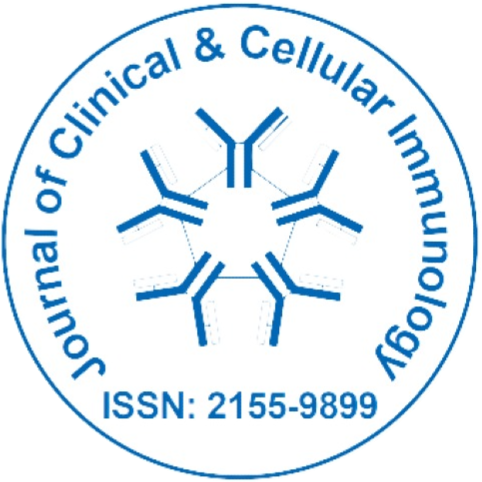
Journal of Clinical and Cellular Immunology
Open Access
ISSN: 2155-9899

ISSN: 2155-9899
Short Communication - (2017) Volume 8, Issue 6
Cardiovascular disease is the major reason of death in patients with Type 2 diabetes mellitus (T2DM) and accounts for up to 80% of associated mortality [1]. Diabetic cardiomyopathy (DCM), initially reported by Rubler and colleagues from diabetic patients who died of heart failure without cardiovascular disease in 1972, is characterized by lipid accumulation in cardiomyocytes, fetal gene reactivation, and cardiac hypertrophy, which together confers a 2-3 fold increased risk of heart failure [2,3]. The pathophysiological mechanisms underlying the characteristic features of diabetic cardiomyopathy are poorly understood, although multiple factors including hyperglycemia, hyperinsulinemia and hyperlipidemia mediated lipid accumulation, apoptosis, ROS stress, inflammation, as well as fibrosis, remodeling of cardiomyocytes are implicated [4]. IL-37 plays an important role in both innate and adaptive immunity, which has been reported to be associated with various kinds of inflammatory and autoimmune diseases [5,6]. Recent studies also showed that IL-37 played a role in tumorigenesis, angiogenesis, furthermore in autophagy and insulin sensitivity [7-10]. In this paper, we mainly point out the widespread potentially regulatory functions of IL-37 in DCM.
Impaired insulin metabolic signaling causes stiffness and diastolic dysfunction of the heart, which is a critical pathophysiological abnormality associated with DCM. Lipid accumulation (lipotoxicity) can directly impede myocyte metabolism and contractility [1,4]. Ballak et al. reported that the glucose tolerance and insulin sensitivity were significantly improved in IL-37 mice after 16 weeks of HFD feeding, meanwhile this type of mice showed reduced plasma levels of cholesterol, free fatty acids and triglycerides, also implying a role in the regulation of cholesterol homeostasis [9]. Mice treated with IL-37 could induce remarkable metabolic changes with higher levels of muscle AMP-activated protein kinase (AMPK), greater rates of oxygen consumption, and increased oxidative phosphorylation, and showed a further 326% increase in exercise performance [11]. Above metabolic regulation role of IL-37 is closely associated with the regulation of AMPK activation, which is known to play a primary role in metabolic reprogramming, and functions as an important protective action against the development of pathogenesis of many cardiovascular diseases including DCM [12]. Therefore, IL-37 may be a target to mitigate the detrimental effects of diabetes mellitus in DCM by regulating the insulin sensitivity and lipid homeostasis.
The production of reactive oxygen species (ROS) has been shown to be increased in patients with diabetes [13]. Metabolic disturbances induce subcellular minor inflammation response in the heart. The innate immune system comprising of neutrophils, dendritic cells, macrophages, mast cells, and eosinophils also induces chronic metabolic inflammation, which is proved to implicate in the development of DCM2. Classical TLR4 and downstream signaling pathway, NLRP3 inflammasome, and regulated inflammatory cytokines such as TNF-α, IL-6, IL-1β and IL-18 are considered to mediate the interaction between cardiac cells and immune cells, which are closely related with the ROS stress, cardiomyocytes apoptosis, and the fibrosis course in the pathophysiology of DCM2, [14]. In addition, study also reported that adaptive immunity also involved in the DCM, as was shown that depletion of Treg cells aggravates myocardial fibrosis [15]. Besides, we found that IL-37 could protect cardiomyocytes from apoptosis and myocardial ROS stress under I/R condition [16], whether it also plays a role in hyperglycemia induced cardiomyocytes apoptosis remains further investigation. Moreover, studies have shown that elevated oxidative stress and inflammation might produce substrates that fuel autophagic protein degradation, and the accumulation of oxidized and nitrated proteins and lipids also indicate an abrogated autophagic processes in DCM, which in consistent with a blunted mammalian target of rapamycin (mTOR) pathway and a reduced activity of AMPK in DCM12, [17]. As showed by the study of Li et al. that IL-37 promoted autophagy in SMMC-7721 and Huh-7 cells via inhibition of the PI3K/AKT/mTOR signaling pathway7, IL-37 may also ameliorate the pathological processes in DCM by inducing autophagy. From the researches done so far, the anti-inflammatory characteristics of IL-37 may make it a potential therapeutic target for DCM.
IL-37 mainly acts through a Smad3-dependent mechanism, and Smad3-TGFβ pathway was associated with fibrosis [18]; but study showed that AAV/human Smad3 delivery observed an antiatherosclerosis therapeutic effect without the expected undesirable effect of TGFβ1-associated fibrosis [19]. Besides, IL-37 was also found to be involved in the pathogenesis of proliferative diabetic retinopathy [20]. In summary, based on the discussion above, IL-37 may play a protective role in DCM, yet studies are still needed to investigate the exact role of IL-37 in DCM in order to provide new evidence for clinical practice.
This work was supported by National Natural Science Foundation of China (81470496, 81573710), National Natural Science Foundation of Shanghai (17ZR1403700) and Chinese Medicine Science Foundation of Shanghai Health and Family Planning Committee (2014JZ006A).
None declared.